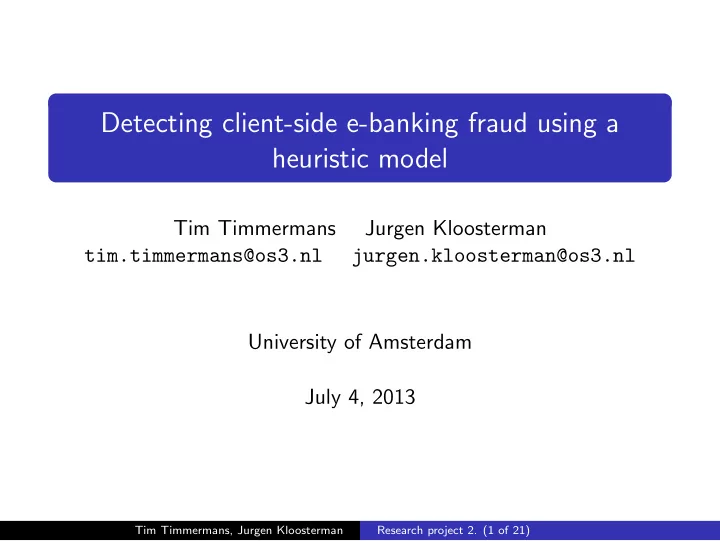

Detecting client-side e-banking fraud using a heuristic model Tim Timmermans Jurgen Kloosterman tim.timmermans@os3.nl jurgen.kloosterman@os3.nl University of Amsterdam July 4, 2013 Tim Timmermans, Jurgen Kloosterman Research project 2. (1 of 21)
Introduction E-banking malware; Man-in-the-browser attack; ”Owns” the browser; Not possible to detect malware with web techniques, i.e JavaScript. Tim Timmermans, Jurgen Kloosterman Research project 2. (2 of 21)
Normal banking web page Figure 1: Normal banking web page Tim Timmermans, Jurgen Kloosterman Research project 2. (3 of 21)
Malicious banking web page Figure 2: Malicious banking web page Tim Timmermans, Jurgen Kloosterman Research project 2. (4 of 21)
Research question To what extend is it possible to detect maliciously injected code into a web page using a heuristic model in order to counteract fraud and what is the performance of such technique in terms of accuracy and execution time? Tim Timmermans, Jurgen Kloosterman Research project 2. (5 of 21)
Current Solutions Pattern recognition; Cannot detect injections from unknown malware. Tim Timmermans, Jurgen Kloosterman Research project 2. (6 of 21)
Related Work CaffeineMonkey: a method to analyse and detect malicious JavaScript (Feinstein et. al.); Prophiler: a filter to examine millions of web pages for malicious content (Canali, Davide, et al.); Zozzle: a low-overhead solution that applies Bayesian analysis to detect JavaScript malware in the browser (Curtsinger, Charlie, et al.). Tim Timmermans, Jurgen Kloosterman Research project 2. (7 of 21)
Approach (1) Supervised machine learning; Labeling of benign and malicious pages Server-side detection mechanism; Goal : detect injections from unknown malware and difficult to bypass. Tim Timmermans, Jurgen Kloosterman Research project 2. (8 of 21)
Approach (2) Figure 3: Normal interaction with an e-banking web site. Tim Timmermans, Jurgen Kloosterman Research project 2. (9 of 21)
Approach (3) Figure 4: Overview of fraud detection implementation. Tim Timmermans, Jurgen Kloosterman Research project 2. (10 of 21)
Model overview Figure 5: Overview of the fraud detection model. Tim Timmermans, Jurgen Kloosterman Research project 2. (11 of 21)
Method: feature extraction Brief selection of features that are identified: iframes; inline styles; hidden elements; input fields; (obfuscated) Javascript; Figure 6: Feature extraction external Javascript, component stylesheets and images. A total of 26 relevant features are identified from HTML, Javascript and URLs Tim Timmermans, Jurgen Kloosterman Research project 2. (12 of 21)
Method: preprocessor Transforms the feature data to a vector as input for the classifier; Assigns a maliciousness score based on the extracted URL features. Figure 7: Preprocessor component Tim Timmermans, Jurgen Kloosterman Research project 2. (13 of 21)
Method: classifier Na¨ ıve Bayes learning algorithm Two components Trainer; Classification. Figure 8: Classifier components Tim Timmermans, Jurgen Kloosterman Research project 2. (14 of 21)
Classifier: trainer Train the classifier on manual labeled malicious and benign pages. Figure 9: Classifier - trainer component Tim Timmermans, Jurgen Kloosterman Research project 2. (15 of 21)
Classifier: classification Classifies an unknown page against the training set using the Bayes’ theorem; Result consists of a probability between 0 and 100% for each class. Figure 10: Classifier - classification component Tim Timmermans, Jurgen Kloosterman Research project 2. (16 of 21)
Results: performance Mean execution time to classify an unknown page: 0.176 seconds. Figure 11: Execution time performance Tim Timmermans, Jurgen Kloosterman Research project 2. (17 of 21)
Results: accuracy 90% accuracy reached with ∼ 32.000 instances in the training set. Figure 12: Accuracy measurements Tim Timmermans, Jurgen Kloosterman Research project 2. (18 of 21)
Results: model validation Experiment to validate the developed model: 1 Train classifier on page adapter by Zeus malware; 2 Classify a page adapted by Citadel malware. Result: classified as malicious with a probability of 100%. Tim Timmermans, Jurgen Kloosterman Research project 2. (19 of 21)
Conclusion Classifier reaches an accuracy of 90% given the used dataset (needs validation with more complete set); The developed model is able to counteract fraud, caused by (unknown) malware; Classification process of a web page is performed with a mean of 0.176 seconds; Improvement of the model may lower impact on resources and optimizing executing time. Tim Timmermans, Jurgen Kloosterman Research project 2. (20 of 21)
References Feinstein, Ben, Daniel Peck, and I. SecureWorks. ”Caffeine monkey: Automated collection, detection and analysis of malicious javascript.” Black Hat USA 2007 (2007). Canali, Davide, et al. ”Prophiler: a fast filter for the large-scale detection of malicious web pages.” Proceedings of the 20th international conference on World wide web. ACM, 2011. Curtsinger, Charlie, et al. ”ZOZZLE: Fast and Precise In-Browser JavaScript Malware Detection.” USENIX Security Symposium. 2011. Tim Timmermans, Jurgen Kloosterman Research project 2. (21 of 21)
Recommend
More recommend